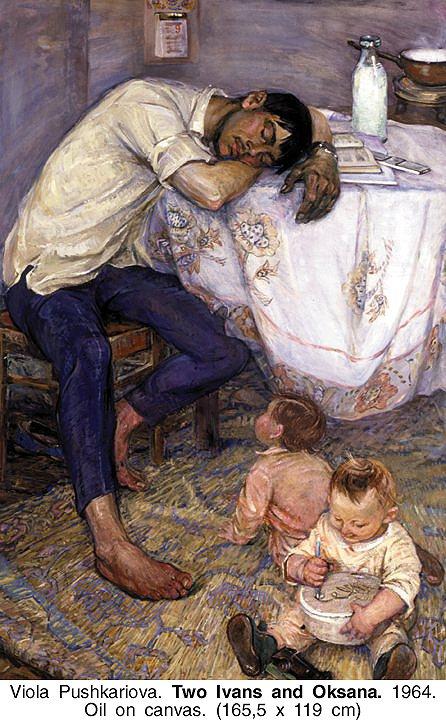
There is a productive tension produced as a result of the coexistence of photographic aspects and painterly qualities in the image and so, this paper aims at explaining how this painting is a translation of photography.
According to Maniichuk and Brady, this painting is an example of social realism, which was the Soviet Union’s official art. Combined with his amazing painting skills, Pushkarova’s piece brings out visual depth, great color coordination, and other rich elements of design. The painting gives the viewer an idea of the Soviet’s domestic life, where a good-looking youth rests his head on the table after what appears to be a long day of hard work. Also, the aspect of a man looking after children is depicted, suggesting a society with the progressive distribution of typically gendered work although the fact he is “sleeping on the job” raises questions about the individual’s capacity to take care of children.
This painting is a translation of a photograph because of the use of pattern. Pushkarova uses a breaking pattern by making the focal point (the young man) to be more distinct with the color, size, and texture that differs from the other objects. This pattern creates another sense of unity throughout the entire piece. While the young man’s hair comprises fine lines, the hair of the two children and the young man’s shirt reveals thick brushstrokes. The young man’s pants, the tablecloth, and the wall surface combine both smooth and thick brushstrokes. The texture used on the carpet and the children’s clothes are quite rough thus, creating an aesthetic appeal of the entire image.
The composition as an element of painting comes out clearly. The painter has organized different components that allow the viewer to wander around the entire painting before finally settling down to the focal point (the young man). The young man is resting and seems fatigued. Just behind this bottle, at the upper right corner, there is a cooking pan with a handle and some steamy food on it. Behind the young person, there is a calendar on a wall that reads “9”. The other objects are the stool that he sits on and a carpet. Two children sit on the carpet with one holding a bowl and a pen as he tries to scribble on the bowl’s lid. The other child gazes surprised at the young man.
In spite of the use of color as a painting element, this painting is a translation of a photograph because of the photographic texture that comes out clearly when light strikes the objects at different angles. Light enters the canvas from an unseen source possibly located on the left side. The light casts a combination of discrete and apparent shadows in the painting’s background and all the present objects. Subtle shadows on the tablecloth, on the gentleman’s face and shirt, give a clue of the possible source of light. Actually, certain sections of the gentleman’s body seem to be more exposed to light than others. For instance, the right leg, right elbow, and flank appear brighter than the other parts of the image.
Looking at the painting shows the use of photographic lines in various ways. By using brushstrokes on the carpet, Pushkarova positions a strong line that creates depth and perspective, which leads the foreground of the photograph to its background. Children are seated on the carpet and a look at the carpet leads one to the wall, table other elements behind the table. The fact that one of the children looks at the young man surprised shows the use of a line to draw the attention of the viewer to the subject (the young man) and to give this subject more importance. Therefore, the use of lines to enhance photography is more than just their use in painting where they help to guide their viewer’s eye from different elements in the composition.
There is a lot of cropping as well, particularly on the walls, a section of the table, and one of the kids. This is another photographic feature in this painting. In addition, there is the use of foreshortening in which elements closer to the lens seem larger and those far from the lens appear smaller. For instance, the young man, the table, and the two kids appear larger than the other elements behind them. Typically, painting uses spatial depth to show those elements in the foreground, background, and middle ground without creating foreshortening as is the case in this painting.
The use of a fairly shallow depth portrays this painting as the translation of a photograph. While the painting seems to have the spatial depth that spans between the different elements of composition, the positioning of the subject is far away from other elements behind him in a way that makes him the focus. The use of light in this painting leaves some elements brighter than the others which may suggest that this could be a photo taken with a flash. For example, the right-hand side of the tablecloth and the young man’s shirt and face appear brighter than the other elements.
In conclusion, this painting uses elements such as line, pattern, texture, depth, shortening, cropping, and light in a way that relates more to photography than to painting thus making the painting a translation of a photograph.
Reference
Maniichuk, Jurii and Brady, Rose. Collections: European Art: Two Ivans and Oksana. Brooklyn, New York: Brooklyn Museum, 2011. Web.